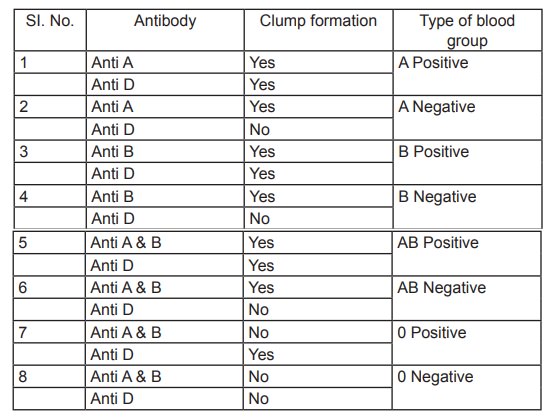Chapter: Biochemistry: Practicals
Determination of Blood Grouping
DETERMINATION
OF BLOOD GROUPING
Aim
To determine the blood group of the given blood
sample.
Principle
This test is based on the antigen antibody
complex formation between the antigen present on the RBC and the antibody
present in the serum.
Reagents and Equipments
1.Anti
A, 2.Anti B, 3.Anti D, 4.Sterlite
Lancet, 5.White marble tiles,6.Sticks for mixing, and 7.Alcohol
Procedure
The middle finger of the individual to be tested
for blood group is cleaned with alcohol and the excess of alcohol is wiped out
with sterile cotton. A clean white tile is taken and it is divided in to four
columns marked as A, B,D and C.
A small drop of anti A is added in the portion
A, anti B in the portion B and anti D in the portion D. The portion C is used
for positive or negative control. A small prick is made on the cleaned finger,
the first drop of blood coming out is wiped off and second drop of blood is
collected directly on the region marked as A, B andD. Immediately, blood is
mixed with the corresponding anti antibody by using the sterile stick and
observed for any agglutination in the form of clump formation.
If the clump is observed in the region marked as
A, the blood group is A and the formation of clump in B shows presence of B
blood group. If the clump is formed in both A and B the blood group is of AB
type. If there is no clump formation in both the blood group it is of O type.
The clump formation in D portion is observed carefully. The formation of clump
in the D region shows presence of Rh positive blood group and if there is no
clump formation it shows the presence of Rh negative blood group.
Clump formation in the regions A and D shows the
presence of A+ blood group and clump formation in the regions B and D shows the
presence of B+ blood group. If clump is formed in all the three regions it
shows the presence of AB+ blood group. No agglutination in regions A & B
and agglutination in region D shows O+ blood group. No agglutination in all the
three regions shows the presence of O- blood group. The following chart shows
the type of blood group and the agglutination with antibodies..
If the clump formation is observed immediately
in A blood group type it can be denoted as A1 type, if it is not
immediate then the blood group is of A2.

Result:
The blood group of
the person is found to be_____
Related Topics